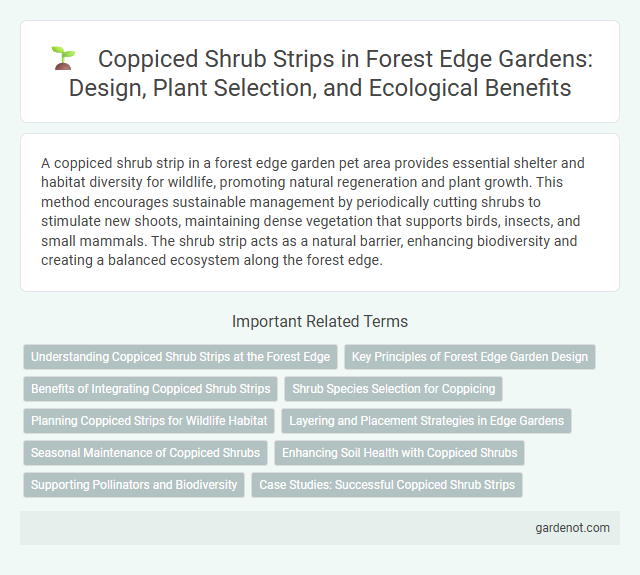A coppiced shrub strip in a forest edge garden pet area provides essential shelter and habitat diversity for wildlife, promoting natural regeneration and plant growth. This method encourages sustainable management by periodically cutting shrubs to stimulate new shoots, maintaining dense vegetation that supports birds, insects, and small mammals. The shrub strip acts as a natural barrier, enhancing biodiversity and creating a balanced ecosystem along the forest edge.
Understanding Coppiced Shrub Strips at the Forest Edge
Coppiced shrub strips at the forest edge create diverse habitats by regularly cutting shrubs like hazel and blackthorn to ground level, encouraging new growth and dense underbrush. This traditional woodland management technique enhances biodiversity by providing shelter and food sources for various wildlife species, including birds, insects, and small mammals. Maintaining these strips promotes sustainable forest edge ecosystems and supports ecological balance in temperate woodland environments.
Key Principles of Forest Edge Garden Design
Coppiced shrub strips in forest edge garden design promote biodiversity by creating layered habitats that support diverse wildlife species. Regular coppicing encourages vigorous regrowth, enhancing edge density and structural complexity essential for microclimate regulation and soil stabilization. Integrating native shrub species ensures ecological balance while providing seasonal resources such as nectar, fruit, and shelter along the forest boundary.
Benefits of Integrating Coppiced Shrub Strips
Coppiced shrub strips enhance biodiversity by creating diverse habitats that support a wide range of wildlife, including pollinators and small mammals. They improve soil health through nutrient recycling and root stabilization, reducing erosion along forest edges. These strips also act as natural windbreaks and microclimate regulators, promoting healthier plant growth in adjacent garden areas.
Shrub Species Selection for Coppicing
Selecting shrub species for coppicing in a forest edge garden requires prioritizing fast-growing, resilient plants like hazel (Corylus avellana), dogwood (Cornus sanguinea), and willow (Salix species). These species produce vigorous regrowth after cutting, enhancing biodiversity and providing sustainable biomass. Proper selection supports habitat creation and maintains soil stability along the garden's periphery.
Planning Coppiced Strips for Wildlife Habitat
Planning coppiced shrub strips in a forest edge garden enhances biodiversity by creating layered habitats that support birds, insects, and small mammals. Selecting native shrub species such as hazel, dogwood, and hawthorn enables sustainable growth cycles through periodic cutting, promoting vigorous regrowth and diverse wildlife food sources. Strategic positioning along forest margins maximizes light penetration and habitat connectivity, vital for pollinators and ground-nesting birds.
Layering and Placement Strategies in Edge Gardens
Coppiced shrub strips in forest edge gardens enhance biodiversity by creating multi-layered habitats that support diverse wildlife. Strategic layering involves alternating shrub species based on height, growth rate, and light tolerance to maximize ground cover and vertical density. Placing fast-growing, sun-loving shrubs on the outer edge encourages gradual canopy closure, while shade-tolerant species thrive closer to the forest interior, optimizing microclimate conditions.
Seasonal Maintenance of Coppiced Shrubs
Coppiced shrub strips require seasonal maintenance to promote vigorous regrowth and maintain biodiversity. Cutting back shrubs annually during late winter or early spring encourages healthy shoots and prevents overgrowth, while removing deadwood reduces pest habitats. Regular monitoring and selective pruning enhance the structural diversity and ecological value of the forest edge garden.
Enhancing Soil Health with Coppiced Shrubs
Coppiced shrub strips improve soil health by promoting nutrient cycling and increasing organic matter through regular cutting and regrowth. These shrubs enhance soil structure, boost microbial activity, and reduce erosion along the forest edge garden. Their dense root systems stabilize soil, improve water retention, and support diverse soil ecosystems essential for forest edge biodiversity.
Supporting Pollinators and Biodiversity
Coppiced shrub strips along forest edges create diverse habitats that encourage pollinator activity by providing continuous nectar and pollen sources throughout the growing season. This management technique promotes structural variety, enhancing biodiversity by supporting a range of insects, birds, and small mammals that depend on shrubland ecosystems. Regular coppicing rejuvenates shrub growth, increasing floral abundance and nesting opportunities critical for sustaining healthy pollinator populations.
Case Studies: Successful Coppiced Shrub Strips
Coppiced shrub strips enhance biodiversity and soil quality by promoting natural regeneration and providing diverse habitats, as demonstrated in the Knepp Estate rewilding project where periodic coppicing increased scrub density and bird populations. The Sussex Wildlife Trust's Forest Edge Garden initiative documented a 40% rise in pollinator activity within coppiced areas, linking healthy shrub cycles to ecosystem service improvements. These case studies confirm that sustainable coppicing methods optimize forest edge management, balancing ecological benefits with landscape aesthetics.
Coppiced shrub strip Infographic

 gardenot.com
gardenot.com